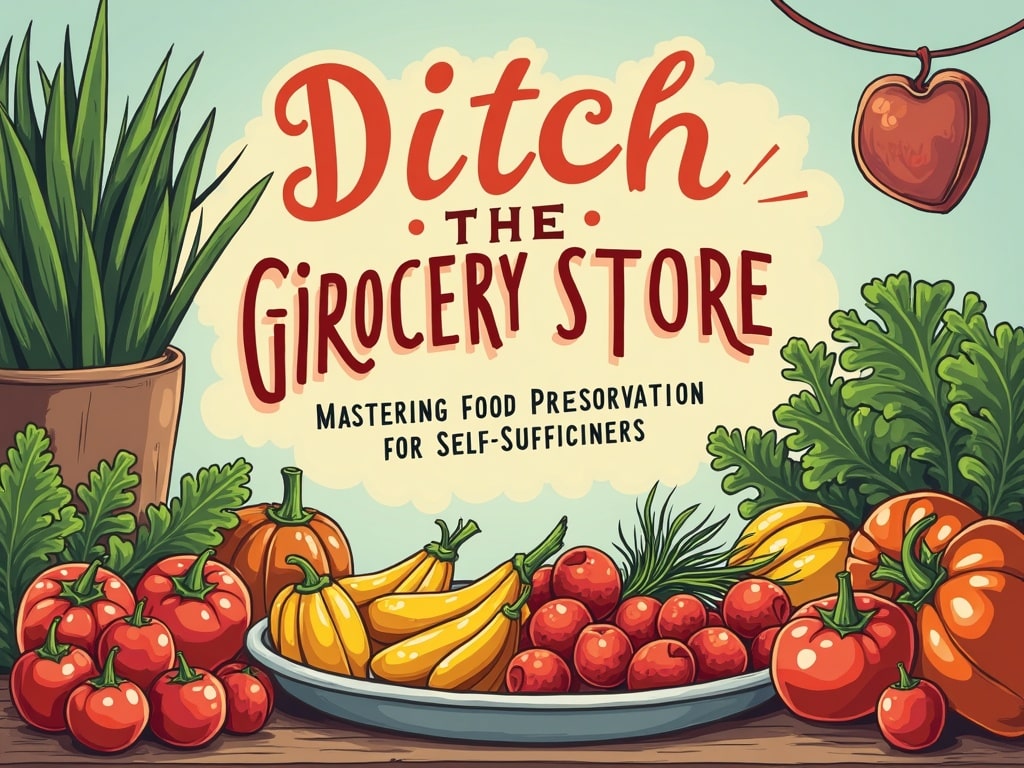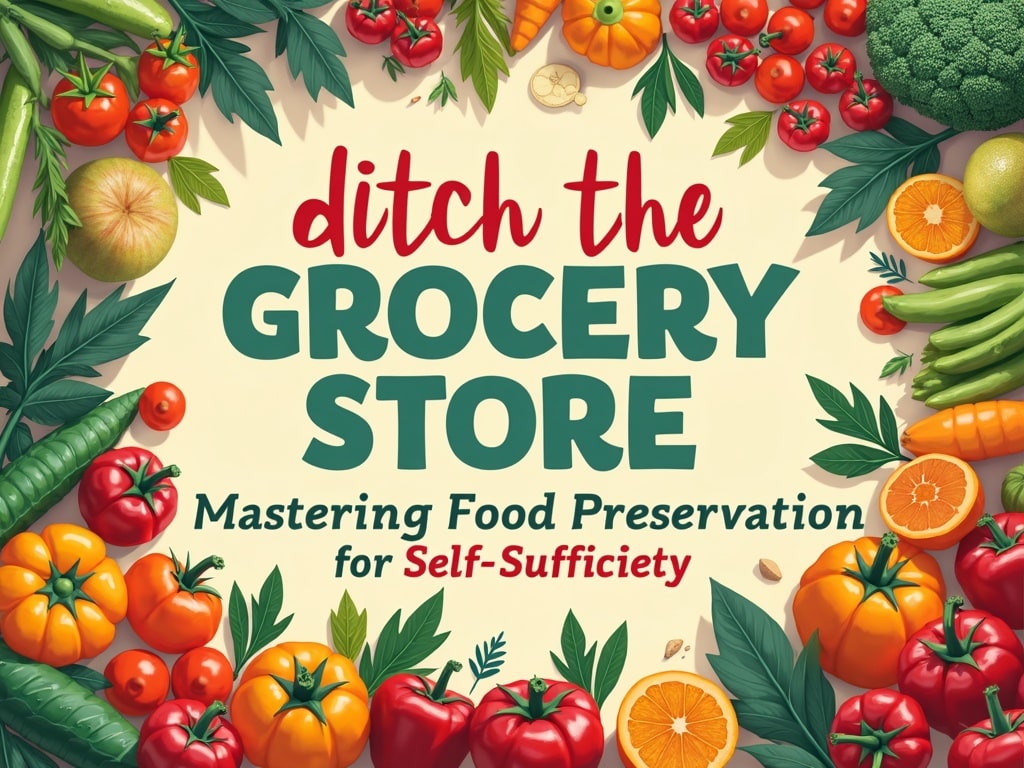Ditch the Grocery Store: Mastering Food Preservation for Self-Sufficiency
What is Food Preservation and Why is it Important for Self-Sufficiency?
Imagine a world where your pantry isn't dictated by the fleeting whims of the grocery store shelves. Picture plump, sun-ripened tomatoes transformed into luscious sauces in the dead of winter, or crispy, sweet pickles adding zing to a summer barbecue, all crafted from your own garden or locally sourced produce. This is the promise of food preservation – a gateway to self-sufficiency and a delicious rebellion against reliance on mass-produced, often flavorless, food.
Food preservation, at its core, is the art and science of extending the shelf life of food by preventing spoilage. This spoilage, caused by enzymatic activity, mold, yeast, and bacteria, renders food unsafe and unappetizing. By understanding and applying various food preservation methods, we can significantly reduce waste, ensure access to nutritious food year-round, and build a more resilient and independent food system.
For the aspiring self-sufficient individual, mastering food preservation is paramount. It allows you to:
- Reduce Reliance on External Food Sources: Less trips to the grocery store mean more control over your food supply and less vulnerability to price fluctuations and shortages.
- Extend the Harvest: Preserve the bounty of your garden or local farm during peak season to enjoy fresh flavors long after the growing season ends.
- Reduce Food Waste: Prevent valuable food from ending up in the landfill by preserving it for later consumption.
- Save Money: Home-preserved foods are often significantly cheaper than their store-bought counterparts.
- Improve Diet: Access to a wider variety of nutritious, home-preserved foods can lead to a healthier and more balanced diet.
- Increase Food Security: Build a reserve of food supplies for emergencies or unexpected circumstances.
Traditional Food Preservation Methods: Echoes of the Past
Before the advent of modern refrigeration and processing techniques, our ancestors relied on ingenuity and observation to develop effective methods of preserving food. These time-tested techniques, still relevant today, offer a connection to the past and a sustainable approach to food storage.
- Drying: Sun-drying, air-drying, and smoking were crucial for preserving meats, fruits, and vegetables by removing moisture, thus inhibiting microbial growth. Think sun-dried tomatoes, jerky, and dried herbs.
- Salting: Packing food in salt draws out moisture and creates a hostile environment for bacteria, effectively preserving meats, fish, and vegetables. Salted cod, sauerkraut, and corned beef rely on this principle.
- Smoking: Exposing food to smoke imparted flavor and helped to preserve it by drying the surface and depositing antimicrobial compounds. Smoked salmon, ham, and cheese are classic examples.
- Fermentation: Utilizing beneficial microorganisms to transform and preserve food, fermentation produces tangy flavors and increases nutrient availability. Sauerkraut, kimchi, yogurt, and cheese are all products of fermentation.
- Pickling: Immersing food in an acidic solution (vinegar, brine) inhibits bacterial growth and imparts a characteristic sour flavor. Pickles, pickled beets, and pickled onions are common examples.
- Cold Storage (Root Cellaring): Storing fruits and vegetables in cool, dark, and humid environments slowed down spoilage by reducing enzymatic activity and microbial growth. Root cellars were traditionally used to store potatoes, carrots, apples, and other root vegetables.
Modern Food Preservation Techniques: Innovation for Longevity
Building upon traditional methods, modern technology has introduced new and efficient ways to preserve food, offering greater convenience and control.
- Canning: Applying heat to sealed jars of food destroys spoilage organisms and creates a vacuum seal, preventing recontamination.
- Freezing: Lowering the temperature of food to below freezing slows down enzymatic activity and microbial growth, extending shelf life significantly.
- Dehydration: Using electric dehydrators to remove moisture from food, offering precise temperature control and faster drying times compared to traditional methods.
- Vacuum Sealing: Removing air from packaging reduces oxidation and inhibits the growth of aerobic bacteria and mold.
- Irradiation: Exposing food to ionizing radiation to kill bacteria, insects, and other pests, extending shelf life and improving food safety. (Note: This method is controversial and not widely used.)
Canning: Sealing in Flavor and Safety
Canning involves heating food in sealed jars to destroy harmful microorganisms and create a vacuum seal that prevents recontamination. It's a versatile method for preserving fruits, vegetables, jams, jellies, sauces, and even meats.
Best Practices for Safe Canning:
- Use Proper Equipment: Invest in a good quality water bath canner for high-acid foods (fruits, jams, pickles) and a pressure canner for low-acid foods (vegetables, meats, soups).
- Follow Tested Recipes: Use recipes from reputable sources like the USDA Complete Guide to Home Canning or Ball Blue Book. Do not alter ingredient ratios or processing times.
- Inspect Jars and Lids: Use only jars and lids specifically designed for canning. Check for cracks or chips in jars and ensure lids are new and free of defects.
- Proper Headspace: Leave the correct amount of headspace (air space between the food and the lid) as specified in the recipe.
- Process Correctly: Follow the recommended processing time for your altitude and the type of food you are canning.
- Check Seals: After processing, check that jars have sealed properly. The lid should be concave and not flex when pressed in the center.
Drying/Dehydrating: Concentrating Flavors and Nutrients
Drying, or dehydrating, removes moisture from food, inhibiting microbial growth and enzymatic activity. It concentrates flavors and creates shelf-stable products like dried fruits, jerky, and herbs.
Foods Best Suited for Drying:
- Fruits: Apples, bananas, berries, grapes, peaches, plums.
- Vegetables: Tomatoes, mushrooms, onions, peppers, herbs.
- Meats: Beef, venison, poultry (for jerky).
- Herbs: Basil, oregano, thyme, rosemary.
Tips for Successful Dehydration:
- Pre-treat Foods: Some fruits and vegetables require pre-treatment (e.g., blanching or dipping in lemon juice) to prevent discoloration and improve flavor.
- Proper Slicing: Slice food evenly to ensure consistent drying.
- Temperature Control: Use the recommended temperature for each type of food.
- Air Circulation: Ensure good air circulation around the food during drying.
- Storage: Store dried foods in airtight containers in a cool, dark, and dry place.
Freezing Food: A Quick and Convenient Option
Freezing is a relatively simple method of preservation that significantly slows down enzymatic activity and microbial growth. It's ideal for preserving fruits, vegetables, meats, and prepared dishes.
Maintaining Quality in Frozen Foods:
- Blanch Vegetables: Blanching (briefly boiling) vegetables before freezing deactivates enzymes that can cause discoloration and loss of flavor.
- Use Freezer-Safe Containers: Package food in airtight containers or freezer bags to prevent freezer burn (dehydration of the surface of the food).
- Cool Food Quickly: Cool cooked food completely before freezing to prevent ice crystal formation.
- Label and Date: Label all packages with the contents and date of freezing.
- Use Within Recommended Timeframe: Most frozen foods maintain optimal quality for 8-12 months.
Fermentation: Harnessing the Power of Beneficial Microbes
Fermentation uses beneficial microorganisms to transform and preserve food, resulting in unique flavors and textures. It also increases the bioavailability of certain nutrients.
Foods Commonly Fermented:
- Vegetables: Cabbage (sauerkraut, kimchi), cucumbers (pickles), beets, carrots.
- Dairy: Milk (yogurt, kefir, cheese).
- Soybeans: Soy sauce, miso, tempeh.
Safe Fermentation Practices:
- Use Clean Equipment: Sterilize all equipment before use to prevent the growth of unwanted bacteria.
- Maintain Anaerobic Conditions: Ensure that the food is submerged in its brine to prevent the growth of mold and other spoilage organisms.
- Monitor Fermentation: Observe the food regularly for signs of spoilage (unpleasant odors, discoloration, mold growth).
- Use the Right Salt Concentration: Use the correct amount of salt to inhibit the growth of undesirable bacteria while allowing beneficial bacteria to thrive.
Pickling: Tangy and Preserved Delights
Pickling involves preserving food in an acidic solution (vinegar, brine) that inhibits bacterial growth. It's a popular method for preserving vegetables, fruits, and meats.
Best Recipes for Pickling:
The possibilities for pickling are endless, but here are a few popular options:
- Cucumber Pickles: Classic dill pickles, sweet pickles, bread and butter pickles.
- Pickled Beets: Sweet and tangy beets with a vibrant color.
- Pickled Onions: Versatile condiment for tacos, salads, and sandwiches.
- Pickled Peppers: Spicy and flavorful peppers for adding heat to dishes.
When searching for pickling recipes, be sure to use reputable sources and follow the instructions carefully to ensure safe and successful results.
Cold Storage (Root Cellaring): Nature's Refrigerator
Root cellaring is a time-honored method of storing crops in a cool, dark, and humid environment. It's ideal for preserving root vegetables, fruits, and other produce that require cool temperatures to prevent spoilage.
Strategies for Effective Cold Storage:
- Maintain Proper Temperature and Humidity: The ideal temperature for most root cellars is between 32°F and 40°F (0°C and 4°C), with a humidity level of 85-95%.
- Provide Good Ventilation: Proper ventilation prevents the buildup of moisture and mold.
- Store Different Crops Separately: Some crops, like apples, release ethylene gas, which can cause other fruits and vegetables to ripen and spoil more quickly.
- Inspect Regularly: Check stored produce regularly and remove any that are showing signs of spoilage.

Equipment and Supplies: Investing in Preservation Success
Each food preservation method requires specific equipment and supplies. Investing in quality tools will ensure successful and safe preservation.
- Canning: Canner (water bath or pressure), jars, lids, jar lifter, funnel, headspace tool.
- Drying: Dehydrator, drying racks, parchment paper.
- Freezing: Freezer-safe containers or bags.
- Fermentation: Fermentation crocks or jars, airlocks, weights.
- Pickling: Jars, vinegar, salt, spices.
- Cold Storage: Root cellar or cool, dark, and humid space.
Safety Considerations: Preventing Foodborne Illnesses
Food preservation involves risks if not done correctly. Following safety guidelines is crucial to prevent foodborne illnesses like botulism, salmonella, and E. coli.
- Use Tested Recipes: Always use recipes from reputable sources and follow instructions carefully.
- Proper Hygiene: Wash hands thoroughly before handling food.
- Sterilize Equipment: Sterilize all equipment that comes into contact with food.
- Ensure Adequate Processing: Process food for the recommended time and temperature.
- Check Seals: Ensure that jars are properly sealed after canning.
- Know the Signs of Spoilage: Discard any food that shows signs of spoilage, such as unpleasant odors, discoloration, or mold growth.
Choosing the Right Method: Matching Food to Technique
The best food preservation method depends on the type of food you're preserving. Here are some general guidelines:
- High-Acid Foods (fruits, jams, pickles): Canning (water bath), freezing, drying.
- Low-Acid Foods (vegetables, meats, soups): Canning (pressure), freezing.
- Fruits and Vegetables: Drying, freezing, fermentation, pickling, cold storage.
- Meats: Drying (jerky), canning (pressure), freezing, salting, smoking.
Reducing Food Waste: Preservation as a Solution
Food preservation plays a vital role in reducing food waste by extending the shelf life of perishable items. By preserving surplus produce from your garden or local farmers market, you can minimize waste and make the most of your food resources.
Building a Sustainable Food Preservation Plan
Creating a sustainable food preservation plan involves assessing your needs, resources, and goals. Consider these steps:
- Assess Your Needs: Determine which foods you want to preserve and how much you need.
- Choose Appropriate Methods: Select preservation methods that are suitable for the foods you want to preserve and your skill level.
- Source Local and Seasonal Produce: Prioritize local and seasonal produce to reduce your environmental impact.
- Implement a Rotation System: Use a first in, first out system to ensure that you use your preserved foods before they lose quality.
- Continuously Learn and Improve: Stay informed about the latest food preservation techniques and best practices.
Advanced Techniques: Expanding Your Preservation Horizons
For experienced food preservation enthusiasts, there are several advanced techniques to explore:
- Freeze-Drying: A method that removes moisture from frozen food under vacuum, resulting in a lightweight and shelf-stable product.
- Modified Atmosphere Packaging (MAP): Packaging food in an atmosphere with a controlled composition of gases to slow down spoilage.
- Sous Vide: Cooking food in a water bath at a precise temperature and then sealing it in a bag for long-term storage.
Benefits and Challenges: Weighing the Pros and Cons
Food preservation offers numerous benefits, but it also presents certain challenges.
Benefits:
- Reduced food waste
- Extended shelf life
- Access to seasonal foods year-round
- Cost savings
- Increased food security
Challenges:
- Time commitment
- Equipment costs
- Risk of foodborne illness if not done correctly
- Potential for nutrient loss
Food Preservation and Emergency Preparedness
Food preservation is an essential component of long-term food storage and emergency preparedness. Having a supply of preserved foods can provide sustenance during power outages, natural disasters, or other unforeseen events.
Reliable Resources and Recipes: Your Guide to Success
Numerous resources are available to help you learn more about food preservation. Here are a few reputable sources:
- USDA Complete Guide to Home Canning: A comprehensive guide to safe canning practices.
- Ball Blue Book Guide to Preserving: A popular resource for canning and other preservation methods.
- National Center for Home Food Preservation: A website with research-based information on food preservation.
Troubleshooting Common Problems: Addressing Preservation Pitfalls
Even with careful planning, problems can arise during food preservation. Here are some common issues and their solutions:
- Jars Not Sealing: Ensure proper headspace, clean jar rims, and follow processing instructions carefully.
- Mold Growth: Discard the food and sterilize the equipment. Ensure that food is properly submerged in brine during fermentation.
- Discoloration: Pre-treat fruits and vegetables to prevent discoloration during drying or freezing.
Costs Associated with Food Preservation
The costs of food preservation vary depending on the method and the scale of your operation. Consider the following expenses:
- Equipment: Canner, dehydrator, freezer, jars, lids.
- Ingredients: Produce, salt, vinegar, spices.
- Energy: Electricity for dehydrating or freezing.
- Storage: Root cellar construction or storage containers.
While there are initial costs involved, food preservation can save you money in the long run by reducing food waste and providing access to affordable, home-preserved foods.

